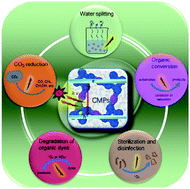当前位置:
X-MOL 学术
›
J. Mater. Chem. A
›
论文详情
Our official English website, www.x-mol.net, welcomes your
feedback! (Note: you will need to create a separate account there.)
Recent advances in conjugated microporous polymers for photocatalysis: designs, applications, and prospects
Journal of Materials Chemistry A ( IF 10.7 ) Pub Date : 2020/03/11 , DOI: 10.1039/d0ta01102a Songhao Luo 1, 2, 3, 4, 5 , Zhuotong Zeng 5, 6, 7, 8, 9 , Guangming Zeng 1, 2, 3, 4, 5 , Zhifeng Liu 1, 2, 3, 4, 5 , Rong Xiao 5, 6, 7, 8, 9 , Piao Xu 1, 2, 3, 4, 5 , Han Wang 1, 2, 3, 4, 5 , Danlian Huang 1, 2, 3, 4, 5 , Yang Liu 1, 2, 3, 4, 5 , Binbin Shao 1, 2, 3, 4, 5 , Qinghua Liang 1, 2, 3, 4, 5 , Dongbo Wang 1, 2, 3, 4, 5 , Qingyun He 1, 2, 3, 4, 5 , Lei Qin 1, 2, 3, 4, 5 , Yukui Fu 1, 2, 3, 4, 5
Journal of Materials Chemistry A ( IF 10.7 ) Pub Date : 2020/03/11 , DOI: 10.1039/d0ta01102a Songhao Luo 1, 2, 3, 4, 5 , Zhuotong Zeng 5, 6, 7, 8, 9 , Guangming Zeng 1, 2, 3, 4, 5 , Zhifeng Liu 1, 2, 3, 4, 5 , Rong Xiao 5, 6, 7, 8, 9 , Piao Xu 1, 2, 3, 4, 5 , Han Wang 1, 2, 3, 4, 5 , Danlian Huang 1, 2, 3, 4, 5 , Yang Liu 1, 2, 3, 4, 5 , Binbin Shao 1, 2, 3, 4, 5 , Qinghua Liang 1, 2, 3, 4, 5 , Dongbo Wang 1, 2, 3, 4, 5 , Qingyun He 1, 2, 3, 4, 5 , Lei Qin 1, 2, 3, 4, 5 , Yukui Fu 1, 2, 3, 4, 5
Affiliation

|
Solar energy is a clean and sustainable energy source. Natural photosynthesis has existed for millions of years, which can convert solar energy into chemical energy needed by living things. Inspired by natural photosynthesis, scientists have developed a series of artificial photosynthetic systems that can use solar energy efficiently for humans. Conjugated microporous polymers (CMPs) are a new class of materials that can be used in artificial photosynthetic systems. This review illustrates the light-harvesting capability and the energy transfer phenomena within the supramolecular structure of CMPs to provide guidelines for the rational design of these polymers with excellent photocatalytic properties and systematically discusses the applications of these materials in the field of photocatalysis including photocatalytic water splitting, CO2 reduction, organic conversion, environmental remediation, and medical health. Finally, this review points out the major challenges in this topic and suggests the next feasible development direction.
中文翻译:

用于光催化的共轭微孔聚合物的最新进展:设计,应用和前景
太阳能是一种清洁,可持续的能源。自然光合作用已经存在了数百万年,可以将太阳能转化为生物所需的化学能。受自然光合作用的启发,科学家们开发了一系列人造光合作用系统,可以将太阳能有效地用于人类。共轭微孔聚合物(CMP)是可以用于人造光合作用系统的新型材料。这篇综述阐明了CMP的超分子结构内的光收集能力和能量转移现象,为合理设计具有优异光催化性能的这些聚合物提供了指导,并系统地讨论了这些材料在光催化领域(包括光催化水分解)中的应用。 ,一氧化碳2还原,有机转化,环境修复和医疗健康。最后,这篇综述指出了该主题中的主要挑战,并提出了下一个可行的发展方向。
更新日期:2020-04-08
中文翻译:

用于光催化的共轭微孔聚合物的最新进展:设计,应用和前景
太阳能是一种清洁,可持续的能源。自然光合作用已经存在了数百万年,可以将太阳能转化为生物所需的化学能。受自然光合作用的启发,科学家们开发了一系列人造光合作用系统,可以将太阳能有效地用于人类。共轭微孔聚合物(CMP)是可以用于人造光合作用系统的新型材料。这篇综述阐明了CMP的超分子结构内的光收集能力和能量转移现象,为合理设计具有优异光催化性能的这些聚合物提供了指导,并系统地讨论了这些材料在光催化领域(包括光催化水分解)中的应用。 ,一氧化碳2还原,有机转化,环境修复和医疗健康。最后,这篇综述指出了该主题中的主要挑战,并提出了下一个可行的发展方向。









































 京公网安备 11010802027423号
京公网安备 11010802027423号